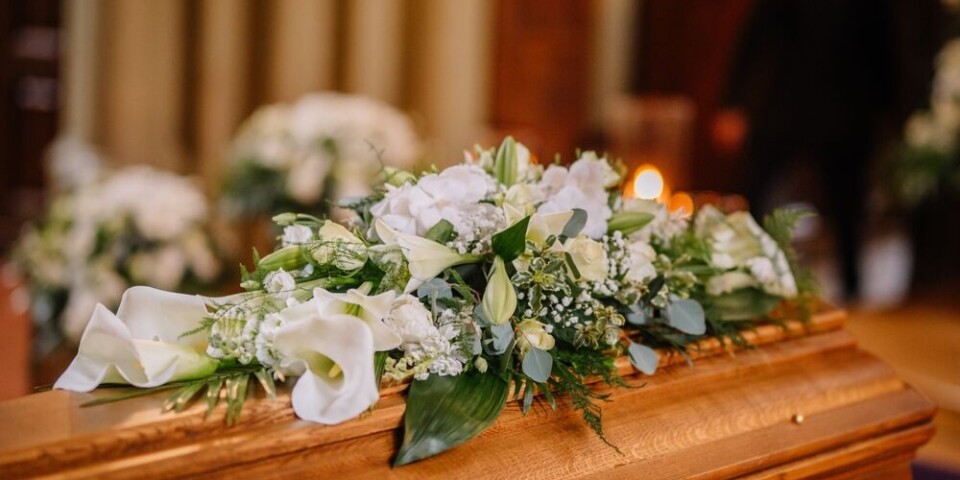-
Must restaurants serve you free tap water in France?
There are several rules surrounding beverages in French restaurants
-
Egg shortage in France: Where to find them and when they will return
Shortages are set to continue, with a minister blaming ‘restrictive laws’ on chicken coops
-
Eating alone at work in France: are attitudes changing?
Why the social taboo is being reconsidered in the modern workplace
Bustling French brasseries offer delicious food and stunning decor
We explore eight iconic brasseries across France for traditional, good-value meals in sumptuous surroundings
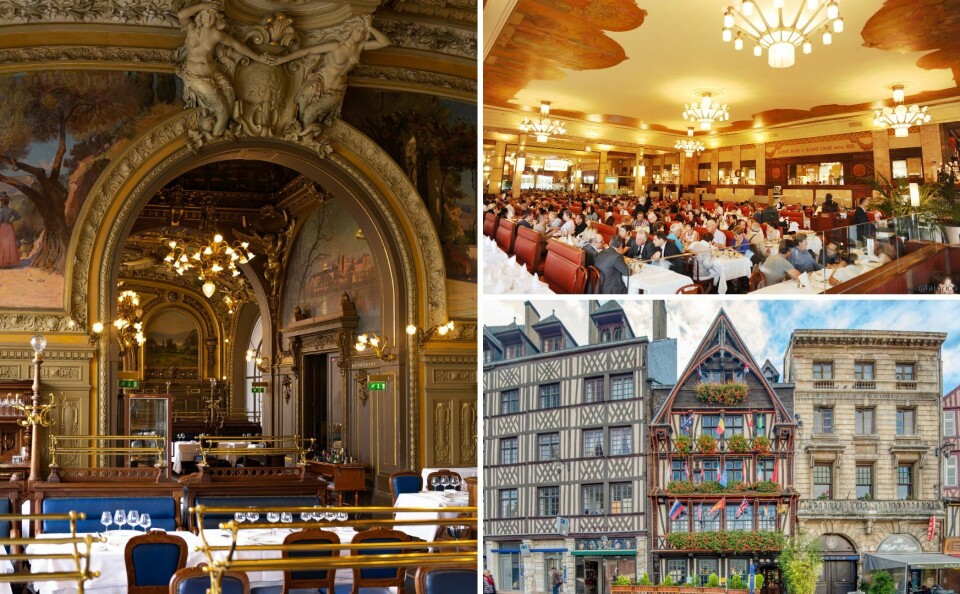
As we are all deliciously and greedily aware, France is jam-packed with restaurants, ranging from the incredibly simple and cheap right up to the eye-wateringly formal and expensive.
It is a cut-throat world, however; restaurants open and close as regularly as sunflowers. But some flourish, becoming iconic in the process.
The cuisine is queen, of course. Who would eat in a restaurant with bad food? But service and decor are also important.
Parisian brasseries are famous for falling short on the service front, but make up for it with fabulous decor – fancy plasterwork, gold paint, large mirrors, brass accessories, mahogany wood, stained glass, red plush seating, enormous pot plants, and elaborate chandeliers throwing soft light over white tablecloths.
The business of Parisian brasseries was originally to brew beer, but after losing the Franco-Prussian war in 1871, an influx of refugees from Alsace arrived in Paris, bringing their love of beer and sauerkraut with them.
Read more: Trend for simple traditional restaurants continues in north France
Traditional dishes in beautiful dining rooms
Brasseries began to be transformed; their premises grew in size, with owners often commissioning stunningly ornate, Belle Epoque buildings.
The cuisine became as important as the beer, and gradually many of them ceased brewing completely.
Compared to bistros, cafés, and restaurants, brasseries are large; they are full of joyful noise, are open all day, and offer a long menu composed of traditional dishes such as soupe à l'oignon, steak au poivre, and coq au vin.
You can have breakfast, lunch or dinner there, or stop for morning coffee, afternoon tea or an early evening drink.
Some of the oldest brasseries retain their extraordinarily beautiful dining rooms, providing the perfect excuse to explore legendary Parisian institutions like Le Grand Colbert, Brasserie Floderer, Bouillon Racine, Bofinger, and the Café du Commerce.
Read more: Cheap and cheerful French restaurants are back in fashion
It would be sinful not to patronise these glorious palaces constructed in honour of French cuisine. Here are a few personal favourites to inspire you.
1. Cheap, decent food at Bouillon Chartier, Paris
One of the best known is Bouillon Chartier in Paris. Opened in 1896, it is one of the cheapest places to eat in Paris, beloved by locals and well as being a firm fixture on the tourist map. (A bouillon was originally designed to be a place for working people to eat at midday).
It now has three branches in the capital, all of them with brass fittings, glass lampshades and dark wooden tables.
In the past the opening hours were limited, and the waiters were paid solely on a commission basis. They had to ‘buy’ the dishes from the kitchen, serve them, and ensure the bill was paid. If it was not, they had to absorb the cost.
It meant that the waiters rushed people through their meals, literally running from table to table, never wasting a minute.
Nowadays, they are salaried and the pace is merely brisk; they no longer object to you lingering over coffee.
Reserving is not possible, however, and queues form at midday and 7.30pm, but everyone always gets seated somehow, especially if they are prepared to share a table.
The restaurant is open and serves food non-stop from 11.30am to midnight.
The food is resolutely traditional. Start with prawns and avocado, herring and potato, or a hard-boiled egg with mayonnaise. Main courses include steak, roast chicken, spaghetti bolognaise, and sausages.
Do not expect fine cuisine, just decent food at knock-down prices in an amazing fin-de-siècle dining room. Going there really is an event.
2. €10 children’s menu at Musée D’Orsay, Paris
Another great restaurant, and ideal if you are sightseeing with children in tow, is the restaurant in the Musée D’Orsay.
The decor is wonderful, adults can enjoy two courses for €31, and the €10 children’s menu (fish fingers or crispy fried chicken with pasta followed by ice cream) is perfect.
To eat there you need to buy a ticket to the museum, but this is no bad thing. (Say hello to that children’s favourite, the polar bear sculpture by François Pompon).
The Musée D’Orsay website has a long list of people who benefit from free entrance. It is also free for everyone on the first Sunday of the month.
Also, a good tip is that the restaurant becomes a salon de thé at 3pm, so you can drink a coffee for €3.30 in order to luxuriate in the decor (if you can resist the cakes, of course).
3. Oysters at 3am Au Pied de Cochon, Paris
Another address worth remembering is Au Pied de Cochon, near the Louvre in Paris because it is open 24 hours and serves food at all hours.
If you want oysters washed down with a glass of champagne at 3am, this is the place to go. After an all-nighter, this is where you can buy croissants for €2 and groggily sip coffee before heading home to bed.
If you can keep your eyes open, you will certainly appreciate the glittering mirrors, brass-work and fancy wallpaper. It is also a great place to go for their Beaujolais Nouveau party in November.
4. Le Train Bleu at the Gare de Lyon, Paris
The main train stations in Paris have been undergoing redevelopment in recent years with the additions of modern shopping malls and food courts, but easily the most beautiful restaurant of them all is the celebrated Le Train Bleu at the Gare de Lyon.
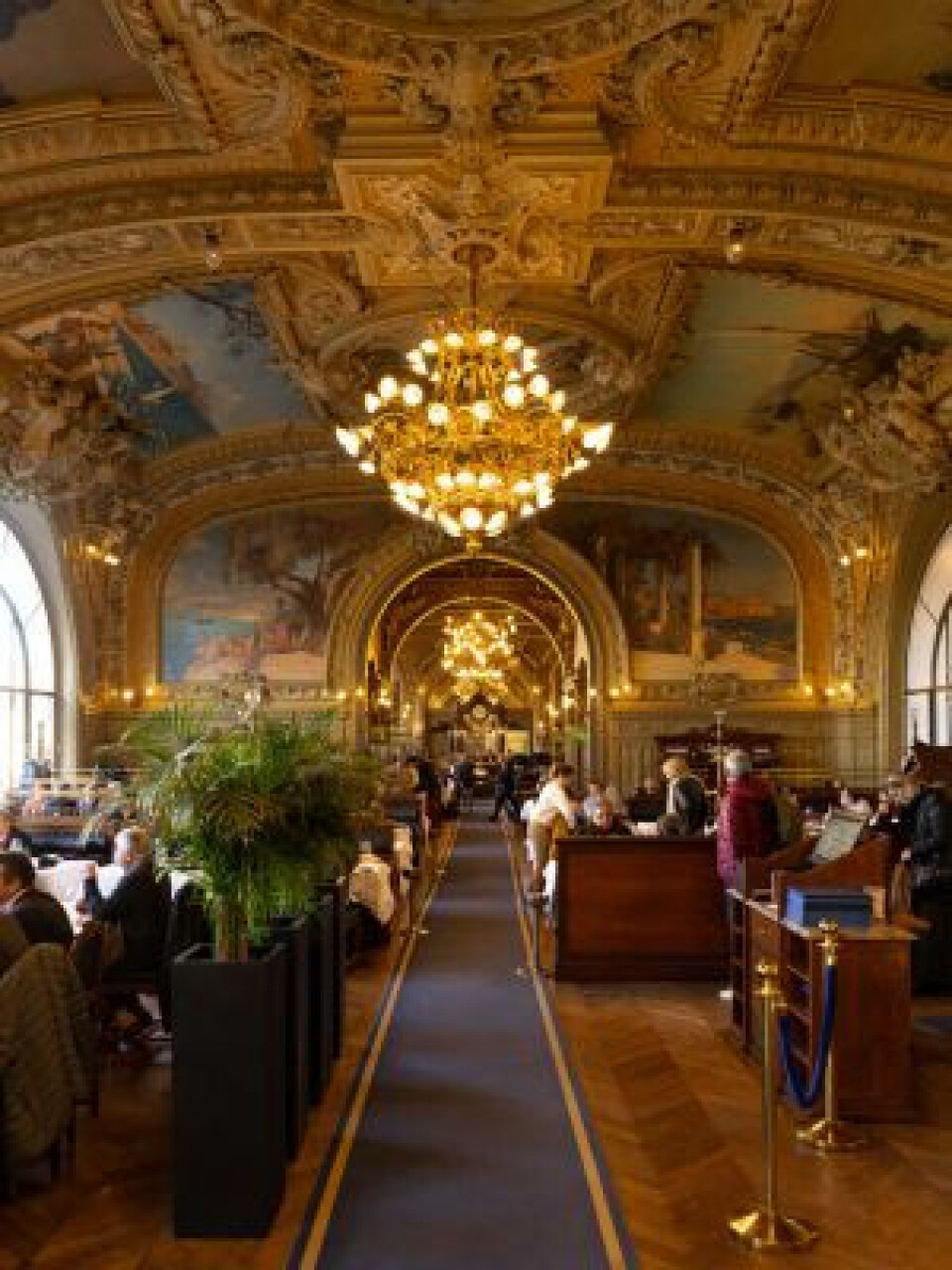
Photo: Beautiful dining room of Le Train Bleu at the Gare de Lyon, Paris; Credit: Le Train Bleu
If you are feeling flush, they have a two-course menu voyageur for €49 which they promise they can serve in 45 minutes.
Otherwise, devour a sandwich on the concourse before exploring their relaxing, luxurious bar-lounge areas where you can wait for your train in classic, gold-leafed comfort just for the price of a drink.
5. Book your table at Brasserie Georges, Lyon
Leave Paris, and you can explore honourable brasserie outposts in France’s other big cities.
Lyon, of course, is famous for its posh restaurants, and you can spend as much as you like on a gastronomic menu in any one of its Michelin-starred temples to fine cuisine. But there is also the delightful Brasserie Georges.
Founded in 1836 by Georges Hoffherr from Alsace, as well as being a brewery it specialises in choucroute.
The decor is wonderful, and the staff genial, although hurried. (Do not dare to dilly-dally when ordering your food!)
Despite being located behind a railway station, almost underneath an overpass, the atmosphere is slightly more up-market than a bouillon like Chartier, although it is far from formal.
The dining room, decorated with photos of celebrities who have graced their tables, is the largest in France, and when the rows of red leatherette benches and booths are full of enthusiastic diners, the noise is impressive.
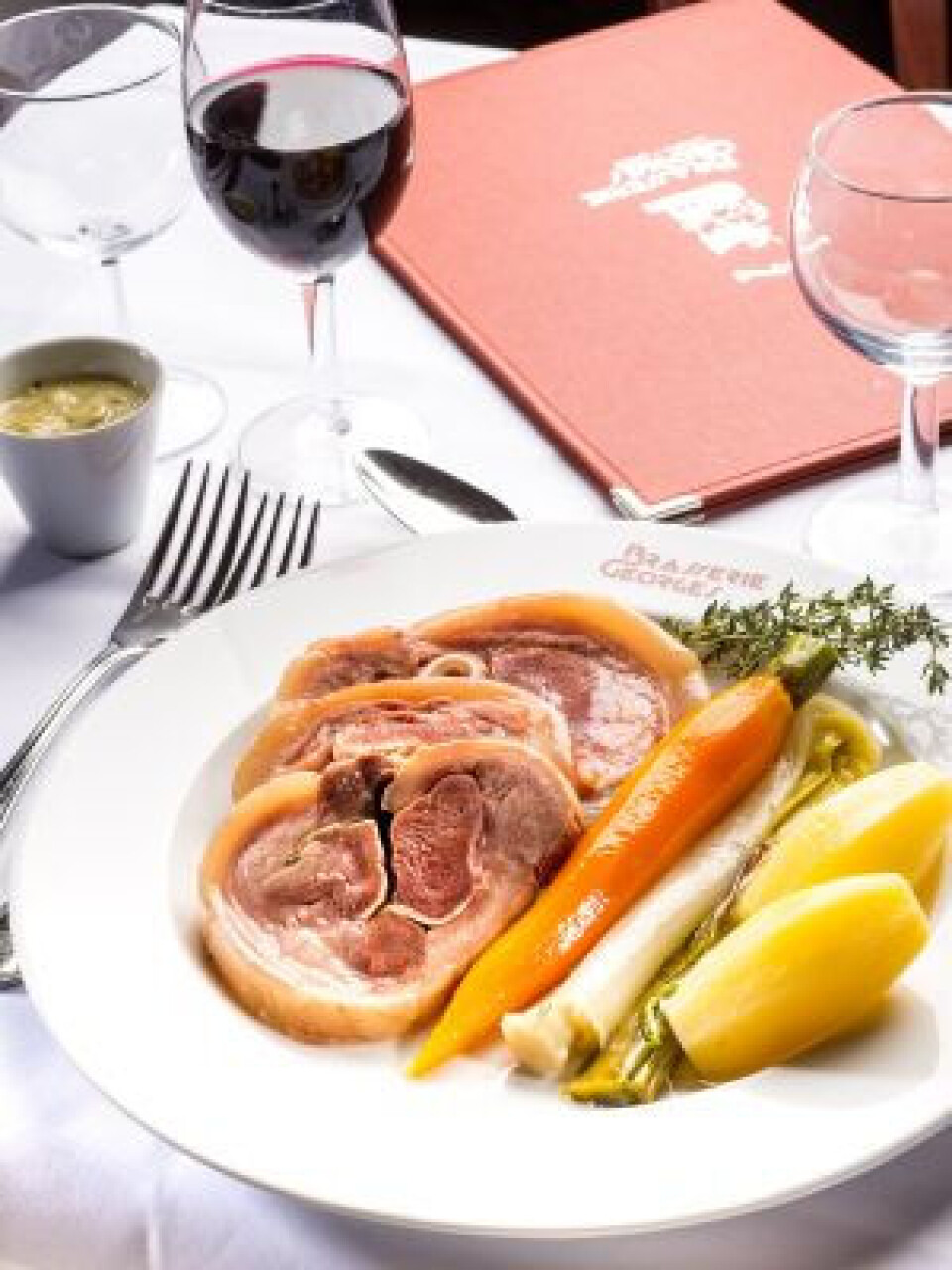
Photo: Traditional food served at Brasserie Georges in Lyon; Credit: Frédéric Durantet
A favourite venue for birthday parties, especially on Saturday nights, the live band plays ‘Happy Birthday’ in a different style for every table (jazz, swing, blues, rock, etc).
You will need a reservation for Brasserie Georges unless you turn up midweek at around 8.30pm, when you might get a table as a walk-in.
The menu is quite meat-heavy but also includes fish, and they have a few vegetarian options. Prices are mid-level, with a daily special at €18. They continue to specialise in sauerkraut, and still brew their own beer on the premises, serving a house blonde, brune and dorée (flavoured with honey).
6. Jaw-dropping decor at Le Cigale, Nantes
Moving towards the Atlantic coast, another venerable and beautiful brasserie is Le Cigale in Nantes, which was founded in 1895.
Open from 7.30pm to half past midnight daily, you can luxuriate in the surroundings for the price of a hot drink, or a glass of wine.
The management say their brasserie is the most beautiful in the world, and it would be hard to dispute this ambitious claim.

Photo: Luxuriate in the surroundings at Le Cigale in Nantes; Credit: Le Cigale
The walls are covered in stunning decorative tiles, and the staff take real pride in their friendly service. (In fact, if you are pushed for time and they are not too full, they will not even mind if you just walk around to look at the jaw-dropping decor).
Families go there on Sundays when they want to push the boat out by ordering massive platters of seafood and delicious desserts.
7. Happy hour at Le Bibent, Toulouse
Further south, Toulouse is also a wonderful city in which to eat out. It has a huge variety of restaurants to choose from, but one of the oldest and definitely one of the most decorative is Le Bibent on the Place du Capitole.
Too often the restaurants on these large, formal central squares are overpriced, stuffy or just plain boring.
Le Bibent, founded in 1843, is none of these things but you might miss its true glory if you sit outside. Go in for a cocktail (they are half price at Happy Hour) or a coffee in order to appreciate the opulent 19th-century interior.
This is reputed to be the place where three Serbian students drew up plans which then led to the assassination of Archduke Franz Ferdinand in 1914...
Eating à la carte at Le Bibent will not break the bank, especially if you choose the daily menu which is €30 for three courses.
This would be a good place to eat cassoulet or a decent steak and there are good fish options. But in all honesty, vegetarians would be better off drinking in the decor and the ambiance while enjoying a cocktail before eating somewhere else.
8. La Couronne, Rouen is France’s oldest restaurant
France’s oldest restaurant is reputed to be La Couronne in Rouen, which proudly declares that it was founded as a tavern in 1345, and that customers watched the torture of Joan of Arc from its windows in 1431.
A dubious pleasure, but noteworthy celebrities who enjoyed a cooler and less fatal welcome include everyone from Salvador Dalí to Grace Kelly. The list of illustrious names is in fact even longer than their very long menu.
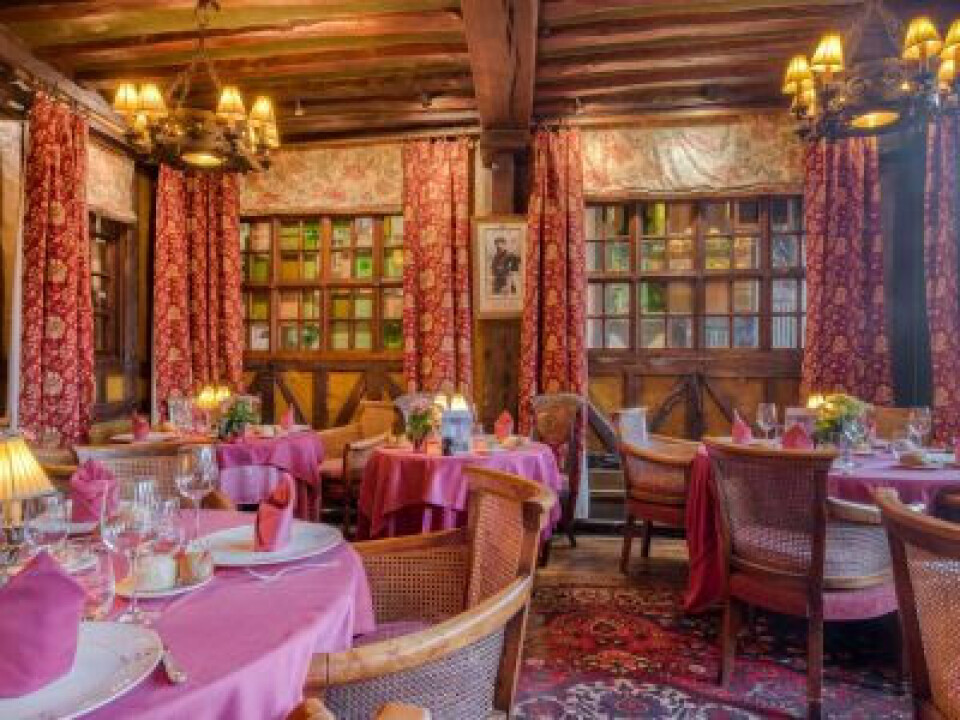
Photo: Just one of the dining rooms at La Couronne in Rouen; Credit: La Couronne
La Couronne’s website has lots of photos of their ornate and exotic dining rooms, along with a whole series of menus designed for groups. Do not let that put you off; look closely and you will see that they can reserve a table for two, and there are menus starting at €29.
If you have the cash, however, you could try the ‘Julia Child menu’ for €65. This was inspired by the famous American food writer Julia Child, whose gastronomic and culinary adventures started at La Couronne.
Read more: Julia Child’s French home remains a cookery school - with no recipes
The paragraphs in Julia Child's book My Life in France (which was turned into the film Julie et Julia starring Meryl Streep) are printed on the menu, if you want to read them.
Who knows, you might even be inspired to embark on your very own odyssey through French cuisine.
Related articles
What has been voted France’s favourite regional dish?
Can French restaurants ask for card details to make a reservation?















